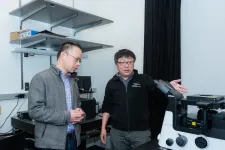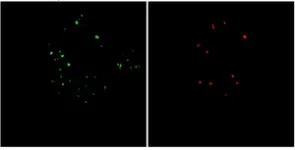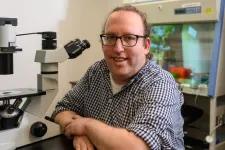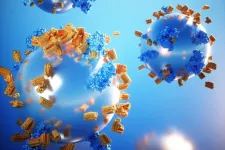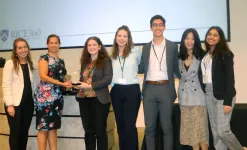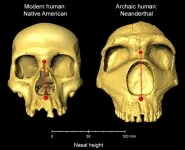(Press-News.org) Collaborative research at the University of Cincinnati has developed a new probe to better study cells that has already led to new knowledge about certain cellular processes.
UC’s Jiajie Diao, PhD, and Yujie Sun, PhD, are lead authors on new research published May 4 in ACS Sensors.
Focus on endolysosomes
The team’s research focused on organelles, or specialized structures that perform various jobs inside cells, called endolysosomes. Lysosomes are organelles that act as the “recycling center” of the cell, reusing broken or malfunctioning building blocks for different purposes, and endolysosomes are a subset of lysosomes that begin as a different organelle called an endosome.
Lysosomes are an important organelle to study because abnormalities can lead to what are called lysosomal storage diseases that cause buildups of toxic substances in cells. Abnormalities in lysosome function are also associated with neurodegenerative diseases and cancer.
“If lysosomes are not functioning normally, then the cell will accumulate lots of waste, eventually leading to cell death,” said Diao, University of Cincinnati Cancer Center member and associate professor in the Department of Cancer Biology in UC’s College of Medicine.
In the process of transitioning from an endosome to a lysosome, these organelles change their pH levels from a neutral environment to an acidic environment. If the environment is not acidic enough, lysosomes cannot do their jobs of clearing and recycling waste properly.
“We are trying to image this process and trying to track the whole changing process of the endolysosome and trying to figure out in which state and which location these endolysosomes will become abnormal,” Diao said.
New probe
Diao and Sun’s team published research last year on the ECGreen probe that turned a brighter shade of green when the cell environment becomes more acidic. While it was a step forward, Diao said ECGreen still had limitations.
“It’s hard to gauge the absolute value, because I can only know it’s become lower,” Diao said. “The intensity becomes higher, but how high is high? There’s no way you can actually calibrate this value.”
The newest probe the team developed is green when in a neutral environment and shifts to a red color when the cell environment turns more acidic.
“So we have red signaling and green signaling, and by calculating the ratio, we can calibrate the exact pH value,” Diao said. “This is more robust and more precise to measure the pH inside the endolysosome, so this is a big advantage.”
“Our probe exhibits excellent pH-sensitive fluorescence in endolysosomes at different stages of interest,” added Sun, a Cancer Center member, associate professor and graduate program co-director in UC’s Department of Chemistry.
Research in action
When a cell’s environment changes, like when a cell is damaged, it needs to increase the number of lysosomes in order to recycle or clean up the cell. But the process cells use to increase the number of lysosomes was not previously known.
Using the new probe, the researchers found no matter what environment a cell is in, and whether it is a normal or abnormal cell, it will keep a constant ratio of endosomes that it then converts into lysosomes.
“By applying the small molecular probe in live cells, we were able to reveal a constant conversion rate from early endosomes to late endosomes/lysosomes,” Sun said. “We feel quite happy we were able to reveal this constant conversion rate.”
Diao noted that for the first time, the team found this process from endosome to lysosome is governed by a complicated protein-controlled process.
“This process is highly regulated, and you cannot skip any steps, even if it’s an emergency,” Diao said.
Probe applications
In addition to the uses described in the published research, Diao said there are a number of other applications for the new probe.
“We can know the location of the endolysosome, we can know the number, we can know the pH change, we can know the size of the endolysosome,” he said. “Eventually we will have all parameters about the endolysosomes inside the cell.”
With all of this information, the team is working to develop a machine-learning software that will be able to profile cell abnormalities and quickly diagnose lysosome problems that may lead to diseases. This method would be faster and more cost effective than current gene and protein sequencing, and in practice could only be a healthy patient taking a simple blood test that tells them if they have risk factors for certain lysosomal diseases.
“You just need to do staining, and in 10 minutes, you have all the information,” Diao said. “We’re actually trying to develop a system with these probes so we can do a fast diagnosis.”
The researchers are also studying treatments that affect the process of transition from endosome to lysosome to speed up the complicated process, including research using light to speed up the process.
“Our research results demonstrate that it is an extremely promising direction in designing and developing small fluorescent probes for bioimaging applications, especially when coupled with high-resolution microscopy,” Sun said. “We will continue developing novel fluorescent probes with multiple functions.”
Other researchers at UC have begun to use the probe, and the team is working to patent and commercialize the technology.
“I think this is a really classic work resulting from collaboration,” Diao said. “Dr. Sun and our group work together and we actually make the whole process very fast and very efficient. We want to accelerate all this discovery.”
“Complementary expertise of Dr. Diao's and my own groups really make it possible to work on these collaborative projects,” Sun added. “The synergistic interaction between our groups is the key of success.”
END
New probe aids novel findings on cell functions
Collaborative University of Cincinnati team publishes research in ACS Sensors
2023-05-08
ELSE PRESS RELEASES FROM THIS DATE:
Model aims to help first responders reach accident sites faster
2023-05-08
Researchers at North Carolina State University have developed a complex model to improve how quickly first responders – such as police and EMTs – reach the scene of vehicle accidents. In computational testing, the model outperformed the existing techniques for getting first responders to accident sites quickly.
“The goal was to figure out the most efficient way to get first responders to an accident,” says Leila Hajibabai, corresponding author of a paper on the work and an assistant professor in NC State’s Edward P. Fitts Department of Industrial and Systems Engineering. “Where should first responders be based ...
From Azerbaijan to China: BGI Genomics promotes thalassemia awareness worldwide
2023-05-08
Thalassemia (thal-uh-SEE-me-uh) is an inherited blood disorder that affects about 300 million people worldwide. Treatments for moderate to severe thalassemia include frequent blood transfusions, chelation therapy to remove excess iron from the blood, and hematopoietic stem cell transplantation (HSCT).
In line with the theme of this year's International Thalassemia Day – "Be Aware. Share. Care: Strengthening Education to Bridge the Thalassemia Care Gap", BGI Genomics will co-host an event with the Shenzhen Municipal Health Commission for thalassemia patients and their family members on May 6, 2023, in Shenzhen, China, providing tips on ...
University of Minnesota to lead new $20M AI Institute focusing on climate-smart agriculture and forestry
2023-05-08
The University of Minnesota Twin Cities announced that it will receive a $20 million grant over five years from the National Science Foundation (NSF) and the U.S. Department of Agriculture’s (USDA) National Institute of Food and Agriculture (NIFA) to lead a new National Artificial Intelligence Research Institute.
Researchers at the AI Institute for Climate-Land Interactions, Mitigation, Adaptation, Tradeoffs and Economy (AI-CLIMATE) aim to leverage artificial intelligence (AI) to create more climate-smart practices that will absorb and store carbon while simultaneously boosting the economy in the agriculture and forestry industries.
The new ...
Hispanic women face inequities affecting maternal health outcomes
2023-05-08
DALLAS, May 8 2023 — Cardiovascular disease is the No. 1 killer of new moms.[1] The American Heart Association, through the new campaign, “My health is our health”/ “Mi salud es nuestra salud” is raising awareness among Hispanic/ Latina moms, especially during pregnancy, about the importance of managing their blood pressure. On average, about one in every 16 Hispanic women aged 20 and older have coronary heart disease, the most common type of heart disease.[2]
Hispanic/Latina mothers hold a special place in their homes when it comes to family decisions. They are considered the head of the family for their key role in raising children and ...
Mirror, mirror: A new way to recognize reverse-image molecules
2023-05-08
Recognizing and separating enantiomers is a difficult task for chemical engineers — one might say it gives them a bit of a headache.
Enantiomers are molecules with virtually identical compositions that mirror one another, like a left and right hand. In chemistry, this property is called chirality. Despite the similarities in their makeup, so-called left- and right-handed enantiomers often exhibit very different properties. Sometimes a drug has an enantiomer that causes undesirable effects. For example, certain drugs have one enantiomer that can cause a headache, ...
Experimental model gets cells to behave as they would in utero
2023-05-08
HOUSTON – (May 8, 2023) – Many birth defects and spontaneous abortions occur during the embryonic development stage known as neurulation, yet we have very little insight into how this critical developmental process unfolds in humans.
The Rice University lab of Aryeh Warmflash has received a five-year, $1.9 million grant from the National Institutes of Health to optimize and develop experimental cell models that can shed light on the self-organizing processes by which ectodermal ...
U of M researchers develop technique for rapid detection of neurodegenerative diseases like Parkinson’s and Chronic Wasting Disease
2023-05-08
University of Minnesota Twin Cities researchers have developed a groundbreaking new diagnostic technique that will allow for faster and more accurate detection of neurodegenerative diseases. The method will likely open a door for earlier treatment and mitigation of various diseases that affect humans, such as Alzheimer's and Parkinson's, and similar diseases that affect animals, such as chronic wasting disease (CWD).
Their new study is published in Nano Letters, a premier journal in the field of nanotechnology published by the American Chemical Society.
“This paper mainly ...
Rice University students design congenital hypothyroidism test for newborns
2023-05-08
HOUSTON – (May 8, 2023) – For newborns with congenital hypothyroidism, early diagnosis spells the difference between a normal, healthy life and lifelong disability.
After learning about the heavy toll the disease takes on children born in parts of the world where testing is limited or absent, a team of Rice University students came together to develop a low-cost screening tool that can detect abnormally high thyroid-stimulating hormone (TSH) levels indicative of dysfunction.
The point-of-care, paper-based test developed ...
Culture, diet, economic factors and more affect CVD risk among Asian Americans
2023-05-08
Statement Highlights:
Health research that considers Asian Americans as a single race and ethnic group may result in over- or under-estimating the risk of Type 2 diabetes and cardiovascular disease among people of diverse Asian American subgroups, by geographic region of descent.
Together, cardiovascular disease and Type 2 diabetes are the leading causes of death and disease in Asian American adults, however, rates vary widely among subgroups. For example, the latest data on the prevalence of Type 2 diabetes in Asian American adults, ages 45-84, reveals a range of Type ...
Nose shape gene inherited from Neanderthals
2023-05-08
Humans inherited genetic material from Neanderthals that affects the shape of our noses, finds a new study led by UCL researchers.
The new Communications Biology study finds that a particular gene, which leads to a taller nose (from top to bottom), may have been the product of natural selection as ancient humans adapted to colder climates after leaving Africa.
Co-corresponding author Dr Kaustubh Adhikari (UCL Genetics, Evolution & Environment and The Open University) said: “In the last 15 years, since the Neanderthal genome ...
LAST 30 PRESS RELEASES:
New software sheds light on cancer’s hidden genetic networks
UT Health San Antonio awarded $3 million in CPRIT grants to bolster cancer research and prevention efforts in South Texas
Third symposium spotlights global challenge of new contaminants in China’s fight against pollution
From straw to soil harmony: International team reveals how biochar supercharges carbon-smart farming
Myeloma: How AI is redrawing the map of cancer care
Manhattan E. Charurat, Ph.D., MHS invested as the Homer and Martha Gudelsky Distinguished Professor in Medicine at the University of Maryland School of Medicine
Insilico Medicine’s Pharma.AI Q4 Winter Launch Recap: Revolutionizing drug discovery with cutting-edge AI innovations, accelerating the path to pharmaceutical superintelligence
Nanoplastics have diet-dependent impacts on digestive system health
Brain neuron death occurs throughout life and increases with age, a natural human protein drug may halt neuron death in Alzheimer’s disease
SPIE and CLP announce the recipients of the 2025 Advanced Photonics Young Innovator Award
Lessons from the Caldor Fire’s Christmas Valley ‘Miracle’
Ant societies rose by trading individual protection for collective power
Research reveals how ancient viral DNA shapes early embryonic development
A molecular gatekeeper that controls protein synthesis
New ‘cloaking device’ concept to shield sensitive tech from magnetic fields
Researchers show impact of mountain building and climate change on alpine biodiversity
Study models the transition from Neanderthals to modern humans in Europe
University of Phoenix College of Doctoral Studies releases white paper on AI-driven skilling to reduce burnout and restore worker autonomy
AIs fail at the game of visual “telephone”
The levers for a sustainable food system
Potential changes in US homelessness by ending federal support for housing first programs
Vulnerability of large language models to prompt injection when providing medical advice
Researchers develop new system for high-energy-density, long-life, multi-electron transfer bromine-based flow batteries
Ending federal support for housing first programs could increase U.S. homelessness by 5% in one year, new JAMA study finds
New research uncovers molecular ‘safety switch’ shielding cancers from immune attack
Bacteria resisting viral infection can still sink carbon to ocean floor
Younger biological age may increase depression risk in older women during COVID-19
Bharat Innovates 2026 National Basecamp Showcases India’s Most Promising Deep-Tech Ventures
Here’s what determines whether your income level rises or falls
SCIE indexation achievement: Celebrate with Space: Science & Technology
[Press-News.org] New probe aids novel findings on cell functionsCollaborative University of Cincinnati team publishes research in ACS Sensors
